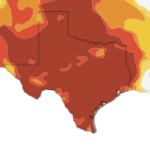This Week in Drought: What a Difference a Rain Makes
With the Texas drought, we experience swings: one week the drought monitor map looks good. Another it looks bad. This week, file it under the “good column.”
In case you missed it, Texas got some rain recently. All of Texas. “Practically the entire state got at least one inch of rain during the last week of September to Oct. 1,” the Texas A&M Agrilife Extension says in their latest crop and weather report, “with many regions getting as much as nine inches, according to the National Weather Service.”
And the results show. The latest US drought monitor map has only three percent of the state in the worst stage of drought, with nearly seventeen percent of Texas completely drought-free. A year ago this week, over 86 percent of the state was in the worst stage of drought.
“The downside, somewhat, was that it was too late to benefit some cotton in the field, and if it was ready to harvest, we may have some quality issues,” Dr. Travis Miller with A&M Agrilife says in the crop and weather report. “But overall, it was a major ‘upside.’ We had almost none of our wheat crop up, though there was quite a bit dusted-in (planted on dry ground), and this will get it up.”
And some of the biggest recipients of rain were those who needed it most. Midland, Odessa, Abilene and down to San Angelo all got a “tremendous” rain, Miller says, up to ten inches and more.
More from Agrilife:
“The rains were also good news for many small towns and rural communities as reservoirs they relied upon for drinking water were at historically low levels because of the drought. For example, Twin Buttes reservoir, that serves San Angelo, gained 8 feet soon after the rains, according to Steve Byrns, AgriLife Extension communications specialist, San Angelo.
O.C. Fisher, another reservoir at San Angelo, was completely dry before the rains, but gained 6.5 feet, Byrns said. Water levels of other reservoirs in the region rose just as dramatically. “The O.H. Ivie Reservoir, reportedly gained 16 feet, and the E.V. Spence, which has gotten so much press in the last year, rose 22 feet — this was a shocker!” Byrns said.”
And those reservoir levels could continue to climb.
But it isn’t clear yet whether we’ll have the drought-busting winter we need. It’s uncertain if El Niño, the counterpart to the drought-making La Niña weather pattern, is on its way.
If we did get a full-fledged El Niño, this is what could happen for Texas, according to forecasts. First, it would be a cooler winter, up to three degrees cooler on average. And it would also be wetter.
This comparison between El Niño and La Niña conditions gives a clear picture of the difference:
But their latest forecast, the National Weather Service says that “due to the recent slowdown in the development of El Niño, it is not clear whether a fully coupled El Niño will emerge.” Things could remain neutral, or a weel El Niño could develop, the weather service says.





